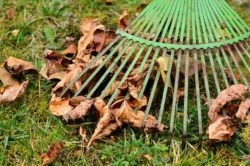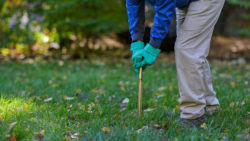Snow may be covering the ground, but the first day of spring is only six weeks away! If you’re the type of person who likes to plan ahead, now is a perfect time to begin thinking about your spring lawn care service and what you need to know.
Here are four lawn care tips to consider as you plan for the spring:
Thin or Weak Turf
As snow cover reduces, you’ll have a better view of your lawn. If you are noticing spots of the turf that look thin or weak, then you may wish to do an early spring seeding. This strategy is better known as “dormant” seeding.
Dormant seeding should be done no later than early spring before the frosty weather has passed. A good timeframe for our service area would be mid- to late February. Seed benefits from frost heaving and cracking and believe it or not, even snowfall. How you might ask? It allows the seed to settle into the surface for better seed to soil contact. Keep in mind, the seed will not germinate until the soil temperatures rise above 50⁰F on a regular basis.
Another benefit of dormant seeding is being able to seed before the ground gets really wet. The grass seed will be on the ground during the wet season and germinate before the weed seed. Best of all, you’ll have more free time to do other things in the spring.
The rate for the seed will stay the same as any regular overseeding. When choosing a seed you want to stay away from any tall fescue seed during a dormant seeding. Try to get a mix of ryegrass and bluegrass. Tall fescue is great, but the soil temps need to be higher for the seed to germinate and you may not get the results you would like.
 Light Raking Prior to First Mow
Light Raking Prior to First Mow
As much effort you put into your fall clean up, there’s bound to be some debris on your lawn that was left behind. We strongly recommend doing a light raking on the lawn. This will help remove any leaf build-up, loosen leaf material, and collect any branches prior to your first mow of the season. When you’re ready to mow, be sure to set your mower at 2.5 inches for the first couple of cuts, then raise the mower to 3.5 inches. Make sure you are staying consistent with a mowing schedule.
Inspect Your Irrigation System
If you have an irrigation system, take some time before the season gets into full swing to turn it on and inspect it. This will allow you enough time to fix any breaks or leaks. It’ll also give you a good opportunity to adjust the sprinkler heads and confirm lawn coverage is accurate. Make sure the nozzles are the proper size and that they are putting out the proper amounts of water. Your irrigation company will also be able to help with any of these issues.
 Request a Soil Test
Request a Soil Test
Finally, if you have not gotten a soil test done in the past 3 years, it’s time! Results from a soil test will help your lawn care service determine if any nutrients are lacking prior to the first application. Your lawn care service will be able to make recommendations to help improve the soil to get the best performance of a lawn program!
